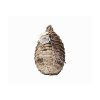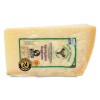An Emilian excellence born when the Parma plain is shrouded in fog and cold.
As you know by now, if you have read my previous posts on cured meats that give prestige to the Emilia-Romagna area, the pig has become a farm animal since the times of the terramaric civilization.
The reason is simple. This animal ate food scraps produced by man and transformed them into excellent meat to eat during the winter.
But to make a typical product such as Culatello di Zibello PDO, it is not enough to have pork meat, two other elements still contribute today to achieve this excellence:
- the microclimate of the lands of the Parma plain;
- the skilled hands of the local butcher.
THE LANDS OF THE PARMA PLAIN
Culatello di Zibello PDO was born in the territories of the following municipalities:
- Bussoleto
- Polesine Parmense
- Zibello
- Soragna
- Roccabianca
- San Secondo
- Sissa
- Colorno
It is a flat area, hot in summer, cold and humid in winter, which has such a particular microclimate that allows Culatello to mature and become what it is.
In the past, this area was entirely covered with oak woods that provided protection and food for the black pig typical of these areas.
It was a small, shaggy, aggressive animal, genetically very close to its ancestor the wild boar. During the autumn, when the oaks dropped the acorns, which are toxic for man but not for him, he made big binges of this fruit.
In this way it could accumulate fat useful for facing the cold winter weather.
Unfortunately, black pigs need two years to reach the ideal weight for slaughter.
This means that before being slaughtered, one winter had to pass and it was the eve of the next.
Due to its slow growth, in the mid-1800s it was replaced by other faster-growing breeds (for example, the English large white, editor's note).
At first attempts were made to hybridize black pigs with allochthonous pigs but the results were not satisfactory.
As a result, breeders firmly focused on breeds that had the fastest growing.
This decision led to the almost disappearance of the black pig from the Parma area until in the 1990s, of the last century, it was reintroduced by some farmers in the Apennine areas.
Another factor that has contributed, over the centuries, to its downsizing have been the reclamation campaigns put in place by the Cistercian monks between 1000 and 1200 which led to the disappearance of the great oak woods to make room for large expanses of stable meadows where to raise the cattle necessary for the production of the milk used to produce Parmesan cheese.
Because of this, the black pig lost its primary source of nourishment and, consequently, it passed from farms in the wild to those in the stable.
A little bit of curiosity: these farms were built near the dairies dedicated to the production of Parmesan cheese because the feed for the pigs was prepared with the whey resulting from the production of the cheese.
THE SECRETS OF CULATELLO
Culatello has always been considered a prestigious salami. The King of cured meats.
This is thanks to the presence of pepper.
Until the discovery of America, only the richest people could afford to use this spice in cooking.
Pepper cost a lot because it came from India and it took a long journey to bring it to Italy.
But how is Culatello made?
The recipe calls for the use of the softer and more important muscle masses of the skinned thigh of an adult pig weighing 250-280 kg.
From 20-22 kg of a thigh, only 6-7 kg will have the privilege of becoming Culatello.
The selected meat will be suitably trimmed to give it the classic "pear" shape and then massaged with Fortana wine and garlic.
At the end of this procedure, ten days are left to pass before salting with a salting mixture consisting of salt and pepper.
After resting for 5 days so that the salt can penetrate well, the so-called "investiture" will take place.
It consists in the bagging of the treated piece of meat, inside the pig's bladder which was previously emptied, turned over, inflated and regenerated in vinegar.
Subsequently, the bladder will be sewn tight and snug so as not to let the air penetrate.
Then, you will have the tying with the twine.
In this phase, the culatello must be placed very tightly to put the meat under pressure.
And eventually everything will be punctured in order to allow the liquids to escape.
At this point the culatelli, after an initial drying phase, pass into special rooms where the seasoning takes place, ranging from a minimum of 10 months for the culatelli of at least 3 kg to an average of 14 months for all the larger sizes.
But for the most valuable qualities, such as those of the Antica Corte Pallavicina, it can even reach 40 months.
A little bit of curiosity: the upper classes did not call Culatello with this name as it was considered vulgar and unbecoming to pronounce. So they referred to this salami calling it: Investiture. This denomination is due to the fact that the pork was stuffed into the pig's bladder.
CONCLUSION
I hope you enjoyed this journey to discover what is rightly considered the King of cured meats and one of the most famous food products of the culinary tradition of Emilia Romagna and Italy.
Don't miss the next articles: subscribe to the newsletter and visit the blog!
See you in the next post!
Ciao and bye bye,
Mamma Rosa



